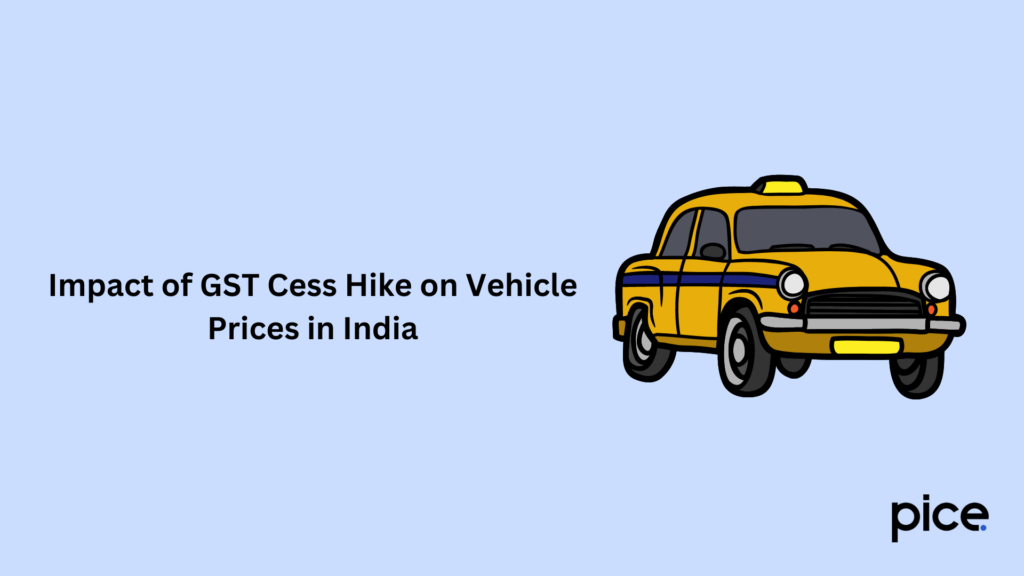What are the reasons behind the GST car price hike?
- 6 Sep 24
- 9 mins

What are the reasons behind the GST car price hike?
Key Takeaways
- Significant Price Hike: The GST cess increase to 25% has notably raised the ex-showroom prices of mid-sized cars, SUVs, and luxury vehicles, impacting affordability.
- Impact on Sales: Popular models like the Honda City, Hyundai Creta, and Maruti Invicto have seen substantial price increases, potentially affecting their sales volumes.
- Market Dynamics: The increased GST cess has led to a price surge across various car categories, with luxury cars and high-end SUVs experiencing the most pronounced hikes.
- Effect on EVs and Hybrids: Despite subsidies and tax credits, the increased cess may offset some benefits for electric and hybrid vehicles, influencing buyer decisions.
- Overall Cost Structure: Factors such as vehicle homologation, ground clearance, and excise duty contribute to the increased cost structure, placing a greater financial burden on consumers.
The GST Council's decision to increase the GST cess on automobiles has resulted in a notable hike in car prices. The Council, responsible for regulating GST rates, decided to increase the cess to 25% for certain vehicle categories. This move aims to generate additional revenue but has directly impacted the pricing of mid-sized, SUVs, and luxury cars.
The recent hike in GST cess has had a significant impact on car prices, particularly affecting mid-sized cars, SUVs, and luxury vehicles. This section delves into how the increased cess has led to a surge in prices for these segments, incorporating key details from various sources.
GST Rate Based on Car Category
| Car Category | GST Rate (%) |
|---|---|
| Small cars (<4m length) | 18 |
| Mid-sized cars | 28 |
| Luxury cars | 28 |
| SUVs | 28 |
Impact of GST Rate and Compensation Cess on Car Prices

The revised GST rate and the hike in compensation cess have led to a price surge across various car models. This increase affects the overall ex-showroom prices, making vehicles more expensive for consumers. For instance, the price of popular models like the Toyota Innova Hycross and Maruti Invicto has seen a noticeable rise due to the increased cess.
The hike in GST cess also affects other vehicle segments, including electric vehicles (EVs), hybrid vehicles, and commercial vehicles. While EVs and hybrid vehicles have been promoted with subsidies and tax credits to encourage green mobility, the increased cess may offset some of these benefits, making these eco-friendly options less attractive to potential buyers.
Additionally, vehicles with specific features like high ground clearance, which are popular in the SUV segment, will see an even more significant price surge. The changes in GST rates and cess slabs also influence the homologation and certification process for new vehicles, further affecting the overall cost structure for automobile manufacturers. As a result, the automotive market in India faces a challenging landscape, with manufacturers needing to adapt their pricing strategies to maintain competitiveness amidst rising costs.
Effect on Ground Clearance and Engine Capacity
The hike in GST cess also factors in the ground clearance and engine capacity of vehicles. Cars with higher ground clearance, such as SUVs, and those with larger engine capacities, are subject to higher cess rates. This differentiation based on vehicle specifications aims to tax luxury and high-end models more heavily.
Cess Rate Applicable on Cars Over and Above GST Rate
| Car Category | Cess Rate (%) |
|---|---|
| Small cars | 1 - 3 |
| Mid-sized cars | 15 |
| Luxury cars | 20 |
| SUVs | 22 |
Impact of GST on the Automobile Industry
- Price Increase: The increase in GST cess has led to a significant rise in car prices, particularly affecting mid-sized, luxury cars, and SUVs.
- Market Dynamics: The higher prices might lead to a decline in sales volumes, particularly in the price-sensitive segments.
- Consumer Sentiment: Higher costs could dampen consumer enthusiasm and impact purchasing decisions.
GST Cess: Honda, Toyota, Fiat and Others Hike Their Car Prices
Examples:
- Honda: Increased prices of models like City, Jazz, and WR-V.
- Toyota: Hiked prices of Innova Crysta and Fortuner.
- Fiat: Adjusted prices for its entire range to reflect the new cess.
GST Cess Hike in Cars: Mid-sized, SUVs, Luxury Cars to Be Expensive
- Mid-sized cars: Average price hike of 5-7%.
- SUVs: Average price hike of 10-12%.
- Luxury cars: Price hike can go up to 15%.
GST Cess Hiked to 25%: SUVs, Luxury Cars to Cost More
| Car Type | Pre-GST Price | Post-GST Price | Increase (%) |
|---|---|---|---|
| SUVs | ₹20,00,000 | ₹22,40,000 | 12 |
| Luxury cars | ₹50,00,000 | ₹57,50,000 | 15 |
Commercial Vehicles and Passenger Vehicles
Commercial vehicles and passenger vehicles are also affected by the GST cess hike. The increased cost of manufacturing and raw materials due to higher cess rates has led to a rise in the prices of commercial vehicles. Passenger vehicles, particularly those in the mid-sized and SUV segments, have seen a more pronounced impact, affecting overall vehicle sales
Kia Carens, Honda Models, and Other Popular Cars

Popular car models such as the Kia Carens, Honda City, and Honda Jazz have also experienced price hikes. The revised prices reflect the increased GST cess, affecting consumer affordability and demand. This hike is part of a broader trend affecting the entire automobile industry.
GST Impact on Car Prices in India
- Maruti Suzuki Baleno: Price increased by 2-3%.
- Hyundai Grand i10: Price increased by 3-4%.
- Mahindra KUV100: Price increased by 2-3%.
- Maruti Suzuki Swift/Dzire: Price increased by 2-3%.
- Tata Tiago: Price increased by 2-3%.
- Maruti Ignis: Price increased by 2-3%.
- Nissan Micra: Price increased by 2-3%.
- Honda Jazz: Price increased by 3-4%.
- Volkswagen Polo: Price increased by 3-4%.
Here is a table showcasing the tax rates applicable to each car segment before and after the GST regime was implemented, along with the difference between the pre-GST and post-GST tax rates:
| Segment | Engine Capacity | Tax Rate Pre-GST (%) | Tax Rate Post-GST (%) | Difference (Percentage Points) |
|---|---|---|---|---|
| Small Cars | < 1200 cc | 27-31 | 28 | -3 to +1 |
| Mid-sized Cars | 1200 cc - 1500 cc | 40-43 | 43 | 0 to +3 |
| Large Cars | > 1500 cc | 45-50 | 48 | -2 to +3 |
| SUVs | > 1500 cc and > 170 mm GC | 45-50 | 50 | 0 to +5 |
| Luxury Cars | Varies | 50-55 | 50-55 | 0 |
| Electric Vehicles | All | 12.5-20 | 12 | -0.5 to -8 |
- Small Cars: Pre-GST tax rate ranged from 27% to 31%, while post-GST it is fixed at 28%.
- Mid-sized Cars: Pre-GST tax rate was between 40% to 43%, and post-GST it remains at 43%.
- Large Cars: Pre-GST tax rate ranged from 45% to 50%, and post-GST it is 48%.
- SUVs: Pre-GST tax rate ranged from 45% to 50%, and post-GST it is 50%.
- Luxury Cars: Pre-GST tax rate was between 50% to 55%, and post-GST it remains in the same range.
- Electric Vehicles: Pre-GST tax rate was between 12.5% to 20%, and post-GST it is reduced to 12%
Vehicle Sales and Market Impact
The increase in car prices due to the GST cess hike has implications for vehicle sales and the broader market. Higher prices may lead to reduced demand, particularly for high-end and luxury vehicles. However, the impact on overall sales will depend on various factors, including consumer preferences and economic conditions.
The recent GST cess hike has significantly impacted car prices in India, especially for mid-sized cars, SUVs, and luxury vehicles. The increase in cess to 25% has led to a notable surge in the ex-showroom prices of these vehicles. This price hike is more pronounced for luxury cars and high-end SUVs, already positioned at a premium price point in the market.
Popular models like the Honda City, Hyundai Creta, and Maruti Invicto have seen substantial price increases, which are likely to affect their sales volumes. The GST Council's decision to raise the cess aims to generate additional revenue but has raised concerns about affordability among consumers and industry stakeholders.
Impact of GST Cess Hike on Vehicle Prices in India

The recent GST cess hike has led to a significant price rise in the Indian automotive market, affecting various vehicle categories including utility vehicles, connected vehicles, and hybrid motor vehicles. This increase has particularly impacted models like the Honda BR-V and Hyundai Verna, which now face higher ex-showroom prices. The new cess rate, coupled with excise duty, has resulted in a noticeable vehicle pricing differential, placing a greater financial burden on consumers.
Additionally, factors such as vehicle homologation, unladen ground clearance, and passenger weight contribute to the overall cost structure, further driving up prices. The hike also affects diesel vehicles and the burgeoning electric vehicle market, which, despite subsidies and tax credits, are now experiencing a shift in their price range. As manufacturers navigate these changes, the Indian consumer market is adjusting to the new economic landscape, balancing affordability with evolving vehicle technology and regulatory compliance.
Conclusion
The GST cess hike has led to a significant increase in car prices, particularly for mid-sized, SUVs, and luxury vehicles. While smaller cars and electric vehicles are relatively less affected, the overall market dynamics have shifted due to the higher tax burden.
Manufacturers and consumers must navigate these changes, balancing affordability with compliance to new tax norms.
💡If you want to pay your GST with Credit Card, then download Pice Business Payment App. Pice is the one stop app for paying all your business expenses.
 By
By 
















